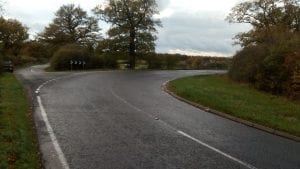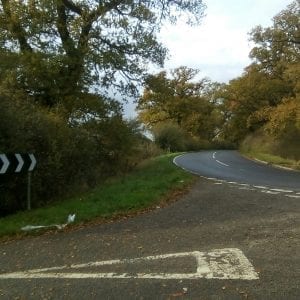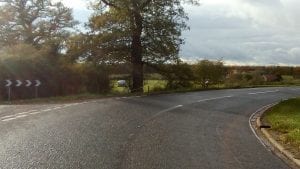 James Smart from Boston has just completed the BIG TOM weekend intensive driving course. This blog emphasises the importance of the thoroughness of training he received.
James Smart from Boston has just completed the BIG TOM weekend intensive driving course. This blog emphasises the importance of the thoroughness of training he received.
Whilst James was practising the use of “limit points” to judge the severity of a country road bend, he came across the following at Grimsthorpe Castle, Lincolnshire. If you look at the image to the right, it looks like a fairly ordinary right bend with a road leading off to the left. However if you look carefully you will see a vehicle has driven straight over the bend. This is why the training is offered to BIG TOM customers. The vehicle concerned mis-judged the severity of the bend and fortunately managed to just miss the large tree that was straight ahead. Tom Ingram (Owner of BIG TOM) says:
“Here at BIG TOM we carefully manage the training provided to give the best experiences to our customers. Although James was driving some 30 miles away from where he will eventually be taking his driving test at Boston driving test centre, the point is that he is being given the opportunity to experience and learn vital driving training techniques. I have to say that the driver of this vehicle in the field was so lucky on this occasion. Too many times we see on these country road bends that the vehicle slides off the road very often hitting a tree head on, and the consequences are very often fatal for the occupants of the vehicle.”
The images below demonstrate just how sharp the bend actually is, it is near on a right angle at 90 degrees. The use of looking at limit points on rural roads is an invaluable technique for being able to recognise if the vehicle is approaching the bend at too high a speed. Tom Ingram continues:
“The key to this technique is vehicle stability and traction to the road. If a vehicle approaches a bend too quickly and the driver brakes sharply whilst steering into the bend, then it places forces between the vehicle and road surface that place great strain on traction. The contact surface area of tyre to road is only about the size of an adult hand for a small vehicle, so it really does pay to think about how you can manage effective handling that is able to accommodate the driving conditions at the time.”
Other considerations that affect the traction include the tyre tread depth and tyre pressures, the weight (mass) of the vehicle which includes the number of occupants and the quality of the road surface. The vehicle seen in the farmers field just to the left of the tree, just managed to squeeze through that gap to the left of the tree and then continued for a good 50 metres into the farmers field. This is a very clear indication that speed was the contributing factor that caused the loss of traction. Tom concludes:
“I very much doubt that the driver had much control or say in precisely where the vehicle came off the road, so this to me looks like a very lucky break for this driver who hopefully will learn from the experience. We should remember that we don’t know if this happened at night in the dark (there are no street lights) and we don’t know if the driver was distracted in any way, or under the influence of drink/drugs or unfamiliar with the road and has not been trained to read the severity of rural road bends. It is impossible to say.”
James who also got to drive on his BIG TOM weekend intensive course to Spalding, Belton House, Grantham, Sleaford and north and southbound on stretches of the A1 said the following of his experience:
“I really liked the way BIG TOM teaches, he tailors the lessons to exactly what you need. I had 4 lots of 5 hour weekend lessons and they were incredibly helpful. Everything was explained well and I was given specific advice for each topic we covered”.






